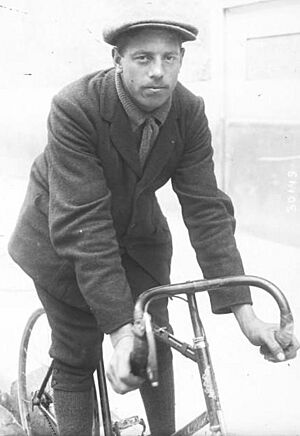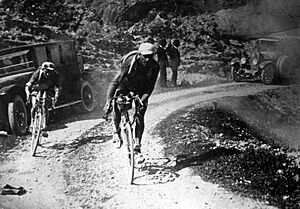Léon Scieur facts for kids

Scieur in 1913
|
|||
| Personal information | |||
|---|---|---|---|
| Nickname | La Locomotive | ||
| Born | 18 March 1888 Florennes, Belgium |
||
| Died | 7 October 1969 (aged 81) Florennes, Belgium |
||
| Team information | |||
| Discipline | Road | ||
| Role | Rider | ||
| Major wins | |||
|
|||
Léon Scieur (born March 18, 1888 – died October 7, 1969) was a famous Belgian cyclist. He is best known for winning the tough 1921 Tour de France race. He also won two stages in that Tour. Before his big win, he had already shown his talent by winning the Liège–Bastogne–Liège race in 1920. He also finished fourth in the Tour de France in both 1919 and 1920.
Contents
Léon Scieur's Early Life
Léon Scieur grew up in a town called Florennes in Belgium. His father was a farmer. Léon first worked as a glassmaker. He didn't start cycling until he was 22 years old! His neighbor, Firmin Lambot, who was also a cyclist, taught him how to ride a racing bike.
Léon Scieur and the Tour de France
Léon Scieur became a professional cyclist in 1913. That year, he rode his first Tour de France, but he didn't finish the race. In 1914, he finished 14th. Even though he didn't win, his hometown of Florennes was still happy. Another cyclist, Philippe Thys, who lived in Florennes, won the Tour for the second time.
Challenges During the Tour
After World War I, the Tour de France started again in 1919. Léon Scieur finished fourth that year. It was a very hard race! He had flat tires many times between Le Havre and Cherbourg. The weather was terrible, and he ran out of spare tires. He had to fix a flat tire by himself.
Fixing a race tire back then was very difficult. You had to take the tire off the wheel, cut the stitching, fix the inner tube, and then sew the tire back up. Scieur got a needle and thread from a woman, but his fingers were too cold to use them. He asked the woman for help. However, the race official told him he couldn't get help. He had to fix it himself, which made him lose a lot of time.
Winning the Tour de France
Léon Scieur tried the Tour de France five times before he finally won in 1921. He was 33 years old. He took the lead early in the race, on the second day. He rode so strongly to keep his lead that reporters gave him a special nickname: The Locomotive. He was known for pedaling very fast in a low gear. He won two stages that year: one from Cherbourg to Brest and another from Nice to Grenoble.
Rivalries and Rules
During the 1921 Tour, another Belgian cyclist, Hector Heusghem, attacked Scieur when Scieur had a flat tire on a mountain called the Col d'Allos. This was against the unwritten rules of cycling at the time. Cyclists usually didn't attack when someone had a mechanical problem. Scieur was very angry! He chased Heusghem, told him off for being impolite, and then raced ahead to win the stage to Grenoble. This argument between them made the race even more exciting for reporters.
The organizer of the Tour, Henri Desgrange, was very strict. He believed cyclists should race as individuals, not as teams. In one stage, two of Scieur's teammates, Firmin Lambot and Louis Mottiat, stayed with the main group instead of chasing Scieur. This was a team tactic, which is normal today. But Desgrange didn't like it. He punished Lambot and Mottiat by moving them to last place in the race.
More Challenges
Even after the feud between Scieur and Heusghem calmed down, the Tour was still full of challenges. In one of the last stages, from Metz to Dunkirk, Scieur broke 11 spokes on his wheel. New rules that year said he couldn't use a replacement wheel unless a judge saw the incident and agreed his original wheel was broken beyond repair. No judge saw what happened. So, Scieur had to carry the broken wheel on his back for 300 kilometers (about 186 miles) to the finish line! He later said it left a mark on his back for 15 years.
Scieur rode the Tour de France for three more years after his victory, but he didn't finish any of them. In 1922, he had to stop because his bike's front fork broke.
Life After Cycling
Léon Scieur stopped racing bikes in 1924. He lived the rest of his life in his hometown of Florennes. He owned a garage and businesses that sold coal and gas. He passed away in 1969.
Career Achievements
Major Results
- 1911
- 10th Liège–Bastogne–Liège
- 1913
- 3rd l'Etoile Carolorégienne
- 3rd Tour du Hainaut
- 4th Overall Tour of Belgium
- Winner Stage 7
- 10th Paris–Tours
- 1914
- 5th Overall Tour of Belgium
- 1919
- 3rd Circuit des Vélodromes
- 4th Overall Tour de France
- 7th National Road Race Championships
- 9th Paris–Brussels
- 1920
- 1st Liège–Bastogne–Liège
- 4th Overall Tour de France
- Winner Stage 11
- 7th National Road Race Championships
- 1921
- 1st
 Overall Tour de France:
Overall Tour de France:
- Winner Stages 3 and 10
- 3rd Paris–Roubaix
- 5th Paris–Dinant
- 6th Liège–Bastogne–Liège
- 10th National Road Race Championships
- 1922
- 3rd Giro della Provincia Milano (fr)
- 5th National Road Race Championships
- 7th GP Wolber
- 8th Paris–Roubaix
- 1923
- 3rd Circuit de Champagne
- 3rd G.P d'Automne
- 5th Liège–Bastogne–Liège
Grand Tour Results Timeline
| 1913 | 1914 | 1915 | 1916 | 1917 | 1918 | 1919 | 1920 | 1921 | 1922 | 1923 | 1924 | |
|---|---|---|---|---|---|---|---|---|---|---|---|---|
| Giro d'Italia | DNE | DNE | N/A | N/A | N/A | N/A | DNE | DNE | DNE | DNE | DNE | DNE |
| Stages won | — | — | — | — | — | — | — | — | ||||
| Tour de France | DNF-7 | 14 | N/A | N/A | N/A | N/A | 4 | 4 | 1 | DNF-3 | DNF-6 | DNF-6 |
| Stages won | 0 | 0 | 0 | 1 | 2 | 0 | 0 | 0 | ||||
| Vuelta a España | N/A | N/A | N/A | N/A | N/A | N/A | N/A | N/A | N/A | N/A | N/A | N/A |
| Stages won |
| 1 | Winner |
| 2–3 | Top three-finish |
| 4–10 | Top ten-finish |
| 11– | Other finish |
| DNE | Did Not Enter |
| DNF-x | Did Not Finish (retired on stage x) |
| DNS-x | Did Not Start (no started on stage x) |
| HD | Finished outside time limit (occurred on stage x) |
| DSQ | Disqualified |
| N/A | Race/classification not held |
| NR | Not Ranked in this classification |
See also
 In Spanish: Léon Scieur para niños
In Spanish: Léon Scieur para niños


